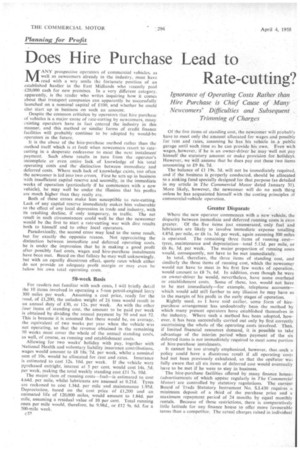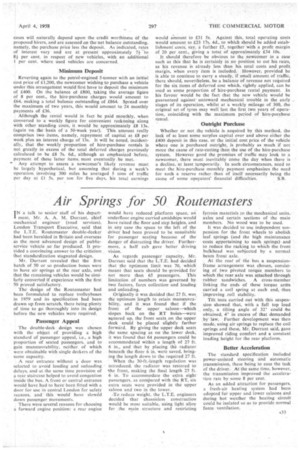Planning or Profit
Page 70

Page 75

If you've noticed an error in this article please click here to report it so we can fix it.
Does Hire Purchase Lead to Rate-cutting?
Ignorance of Operating Costs Rather than Hire Purchase is Chief Cause of Many Newcomers' Difficulties and Subsequent Trimming of Charges
MANY prospective operators of commercial vehicles, as well as newcomers already in the industry, must have read with a wry smite the fortunate position of an established haulier in the East Midlands who recently paid 120,000 cash for new premises. In a very different category, apparently, is the reader who writes inquiring how it comes about that transport companies can apparently be successfully launched on a nominal capital of £100, and whether he could also start up in business on such an amount.
Despite the common criticism by operators that hire purchase of vehicles is a major cause of rate-cutting by newcomers. many existing operators have in fact entered the industry in this manner, and this method or similar forms of credit finance facilities will probably continue to he adopted by would-be operators in the future.
It is the abuse of the hire-purchase method rather than the method itself which is at fault when newcomers resort to ratecutting in a desperate endeavour to meet the next instalment payment. Such abuse results in turn from the operator's incomplete or even entire lack of knowledge of his total operating costs and the distinction between immediate and deferred costs. Where such lack of knowledge exists, too often the newcomer is led into two errors. First he sets up in business with insufficient capital reserve and secondly, in the immediate weeks of operation (particularly if he commences with a new vehicle), he may well be under the illusion that his profits are much higher than they really are.
Both of these errors make him susceptible to rate-cutting. Lack of any capital reserve immediately makes him vulnerable to the effect of any local depression in trade and industry, with its resulting decline, if only temporary, in traffic. The net result in such circumstances could well be that the newcomer would be the first to start a rate-cutting war with dire results both to himself and to other local operators.
Paradoxically, the second error may lead to the same result, but for exactly the opposite reason. Not appreciating the distinction between immediate and deferred operating costs. he is under the impression that he is making a good profit after possibly fuel costs, wages and hire-purchase instalments have been met. Based on that fallacy he may well unknowingly. but with an equally disastrous effect, quote rates which either do not provide an adequate profit margin or may even be below his own total operating costs. .
50-week Basis For readers not familiar with such costs, I Will briefly detail the 10 items involved in operating a 5-ton petrol-engined lorry 300 miles per week. Assuming a cost price, ready for the road, of £1,200, the unladen weight of 2+ tons would result in an annual duty of £30, or 12s. per week. As with the other four items of standing cost, the amount to be paid per week is obtained by dividing the annual payment by 50 and not 52. This is because it is assumed that there would be, on average, the equivalent of two weeks per year when the vehicle was not operating, so that the revenue obtained in the remaining 50 weeks must cover the whole of the annual standing costs, as well, of course, as running and establishment costs.
Allowing for two weeks' holiday with pay, together with National Health and voluntary liability insurance contributions, wages would amount to £8 13s. 7d. per week, whilst a nominal sum of 10s would be allocated for rent and rates. Insurance is estimated to cost 12s. 10d. per week. If the vehicle were p;irchased outright, interest at 3 per cent, would cost 14s. 5d. per week, making the total weekly standing cost £11 7s. 10d.
The major item of running costs—fuel—is estimated to, cost 4.64d. per mile, whilst lubricants are assessed at 0.21d. Tyres are reckoned to cost 1.34d. per mile and maintenance I.95d. Depreciation, based on the cost price of £1,200 and an estimated life of 120,000 miles, would amount to 1.84d. per mile, assuming a residual value of 10 per cent. Total running costs per mile would, therefore. be 9.98d., or £12 9s. 6d. for a 300-mile week.
el/
Of the five items of standing cost, the newcomer will probabty have to meet only the amount allocated for wages and possibly for rent and rates, assuming he has his vehicle in a public garage until such time as he can provide his own. Even with wages, however, if he is an owner-driver he may -well not pay himself the statutory amount or make provision for holidays. However, we will assume that he does pay out these two items amounting to £9 8s. 7d.
The balance of £1 19s. 3d. will not be immediately required, and if the business is properly conducted, should be allocated to a sinking fund specially designed for that purpose (as detailed in my article in The Commercial Motor dated January 31). More likely, however, the newcomer will do no such thing unless he has acquainted himself with the costing principles of commercial-vehicle operation.
Greater Disparate
Where the new operator commences with a new vehicle, the disparity between immediate and deferred running costs is even greater. Of the. five items just enumerated, only fuel and lubricants are likely to involve immediate expense totalling 4.85d. per mile, or E6 Is. 3d. per week, again assuming 300 miles is operated. The remaining three items of running cost— tyres, maintenance and depreciation—total 5.I3d. per mile, or £6 8s, 3d. per week. The major proportion of running costs would, consequently, not have to be met immediately.
En total, therefore, the three items of standing cost, and similarly the three items of running cost, which the newcomer would not have to meet in his first few weeks of operation, would amount to £8 7s. 6d. In addition, even though he were an owner-driver he would, nevertheless, have some overhead or establishment costs. Some of these, too, would not have to be met immediately—for example, .telephone accounts— which would add still further to any illusion he may have as to the margin of his profit in the early stages of operation.
Rightly used, as I have said earlier, some form of hirepurchase arrangement has undoubtedly been the method by which many present operators have established themselves in the industry. Where such a method has been adopted, however, it has been successfully carried out only by first correctly ascertaining the whole of the operating costs involved. Then, if limited financial resources demand, it is possible to take advantage of the interim period when payment of the six deferred items is not immediately required to meet some portion of hire-purchase instalments.
It cannot be too strongly emphasized, however, that such a policy could have a disastrous result if all operating costs had not been previously calculated, so that the operator was fully aware that all six items of deferred cost would eventually have to be met if he were to stay in business.
The hire-purchase facilities offered by many finance houses (advertisements of which appear regularly in The Commercial Motor) are controlled by statutory regulations. The current Board of Trade Statutory Instrument No. S.I.430 requires a minimum deposit of a third of the purchase price and a maximum repayment period of 24 months by equal monthly rentals. Because of these restrictions, there is comparatively little latitude for any finance house to offer more favourable terms than a competitor. The actual charges raised in individual cases will naturally depend upon the credit worthiness of the proposed hirers, and are assessed on the net balance outstanding, namely, the purchase price less the deposit. As indicated, rates of interest vary and are at present approximately 7+ -to 8i per cent. in respect of new vehicles, with an additional 1 per cent, where used vehicles are concerned.
Minimum Deposit
Reverting again to the petrol-engined 5-tonner with an initial cost price of £1,200, the newcomer wishing to purchase a vehicle under this arrangement would first have to deposit the minimum of £400. On the balance of £800, taking the average figure of 8 per cent., the hire-purchase charges would amount to £64, making a total balance outstanding of £864. Spread over the maximum of two years, this would amount to 24 monthly payments of £36.
Although the rental would in fact be paid monthly, when converted to a weekly figure for convenient reckoning along with other standing costs, it would be approximately £8 13s.. (again On the basis of a 50-week year). This amount really comprises two items, namely, repayment of capital at £8 per week plus an interest charge of 13s. It will be noted, incidentally, that the weekly proportion of hire-purchase rentals is not greatly in excess of the total deferred charges previously calculated to be £8 7s. 6d., although as emphasized -before, payment of these latter items, must eventually be met. •
• Any attempt to assess a newcomer's likely revenue Must be largely hypothetical, but assuming that during a week's operation. involving 300 miles he averaged 5 tons of traffic per day at £1 5s. per ton for five days, his total earnings would amount to £31 5s. Against this, total operating costs would amount to £23 17s. 4d., to which should be added establishment costs, say, a fuither £5, together with a profit margin of 20 per cent., giving a total of approximately £34 10s.
It should therefore be obvious to the newcomer in a case such as this that he is certainly in no position to cut his rates, as his revenue is already less than his total costs and profit mar-gin, when every item is included. However, provided he is able to continue to carry a steady, if small amount of traffic, there should, nevertheless, be a balance of revenue not required for the six items of deferred cost which, rightly applied, can be used as some proportion of hire-purchase rental payment. In his favour would be the fact that the new vehicle would he guaranteed against untoward mechanical trouble in the early stages of its operation, whilst at a weekly mileage of 300, the original set of tyres may well last the first two years of operation, coinciding with the maximum period of hire-purchase rental.
Outright Purchase
Whether or not the vehicle is acquired by this method, the lack of at least some surplus capital over and above either the £400 deposit in this case, or the initial cost price of the vehicle where one is purchased outright, is probably as much if not more the cause of rate-cutting than the use of the hire-purchase system. However good the promises of traffic may look to a newcomer, there must inevitably come the day when there is a decline, at least temporarily. In such circumstances, need to meet the hire-purchase monthly payment emphasizes the need for such a reserve rather than of itself necessarily being the cause of some operators' financial difficulties. S.B.












































































































